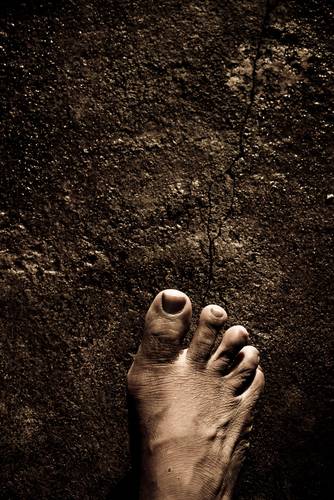Dear Willow,
When I run, should I have active feet? In yoga, active feet support the knees. My knees complain when I run, even a couple miles a few times a week. I wear barefoot running shoes. Any tips would be greatly appreciated.
Sincerely,
Cranky Knees
Dear Cranky Knees,
Yes, keep those feet flex-able! Maximize their capability for standing, walking, running, or yoga-ing by increasing the dexterity and ranges of motion in your toes, feet, and ankles. Running with less on them is a great starting point. I ended a lifetime of ‘cinder block weighted foot binding’ years ago by tossing out all running shoes and moving about with bare feet any chance I got, walking or running. My gait normalized and now I run with sandals in the summer and a pair of minimalist shoes in the winter.
The heavy clodhoppers I was running in exacerbated bunions, pigeon toes, internal rotation of the tibias, and two decades of knee issues. The reason? Weak feet! My feet had become stupid. Their innate intelligence and wisdom was reduced from years of solitary confinement. The shoes were nothing more to my feet than padded rooms with no ventilation and the socks were the white straightjackets.
I broke free! With active feet and minimal running shoes, I relearned how to wiggle my toes and take the piggies to market. They were highly sensitized for a short time, but their intelligence of both afferent and efferent motor signaling returned the more I strolled bare. Instead of relying on my eyes to look for safe places to put my feet down, my soles told me where to stand my ground and with how much force.
Active feet are great for steadying oneself both physically and emotionally. You will build awareness to your lower extremities and connect to the signals residing in the legs. We all have legs and feet, but very few people know how to use them fully. Few people can lift one toe at a time or spread their foot bones. Can you? This Forrest Yoga specific action and cue provides an increase in healing and strength in the plantar surface of the feet, but is not necessary to continue when running. Having active feet means to lift and spread the toes – to create muscular activation in most of the muscles of the toes, feet, ankles and calf. This is done primarily to strengthen the top of the feet and open up areas that are compressed from wearing socks, shoes, and unnecessary arch support. Let your feet be loose and unrestricted while running. It is essential the surface of the feet retain their ability to sense the terrain and flex accordingly.
If you run with stiff feet from having unnecessary support, this can create a residual effect of rigidity throughout the rest of the body. The ankles can lock up and weaken making you more prone to strains and sprains. Full-time calf flexing can bring about knee pains or injuries because of the constant workload demand. Toes must be allowed to open and spread at all times for minimal injuries. In running, toes are also needed to grip the surface of the ground and the big toe pushes off the ground to create forward motion. Let the feet do their job and the rest of the body may be lead.
 You might have a friend follow you running while video recording to look for holding patterns or areas of the body that need to be strengthened. Resist tensing when you run. Weak areas appear to show a buckling effect while rigid – flexed areas don’t move as much. Look for these contrasts and focus on building strength in weak areas and stretching areas that are too tight.
You might have a friend follow you running while video recording to look for holding patterns or areas of the body that need to be strengthened. Resist tensing when you run. Weak areas appear to show a buckling effect while rigid – flexed areas don’t move as much. Look for these contrasts and focus on building strength in weak areas and stretching areas that are too tight.
This is the same philosophy employed with intelligent yoga. Always keep a small bend in your knees to use the energy stored in your quads and hamstrings to support your knee joint. Do not ever lock your knees. Let them function like a well-lubricated joint needs to. If you notice you rely on your knee joints to keep you steady, stop immediately and bend them so you affirm your position on the earth with awareness to your strong legs.
Horse stance, bridge pose, and down dog at the wall are great positions that help build leg awareness and strength. Add these to your practice, holding them for up to ten long breaths. After two weeks of adding in strength and flexibility in areas you notice need the balance, check in with me. Let me in on how you are doing with your knees.
Willow
(Click here for articles by Willow)
Photos courtesy of Shutterstock.






